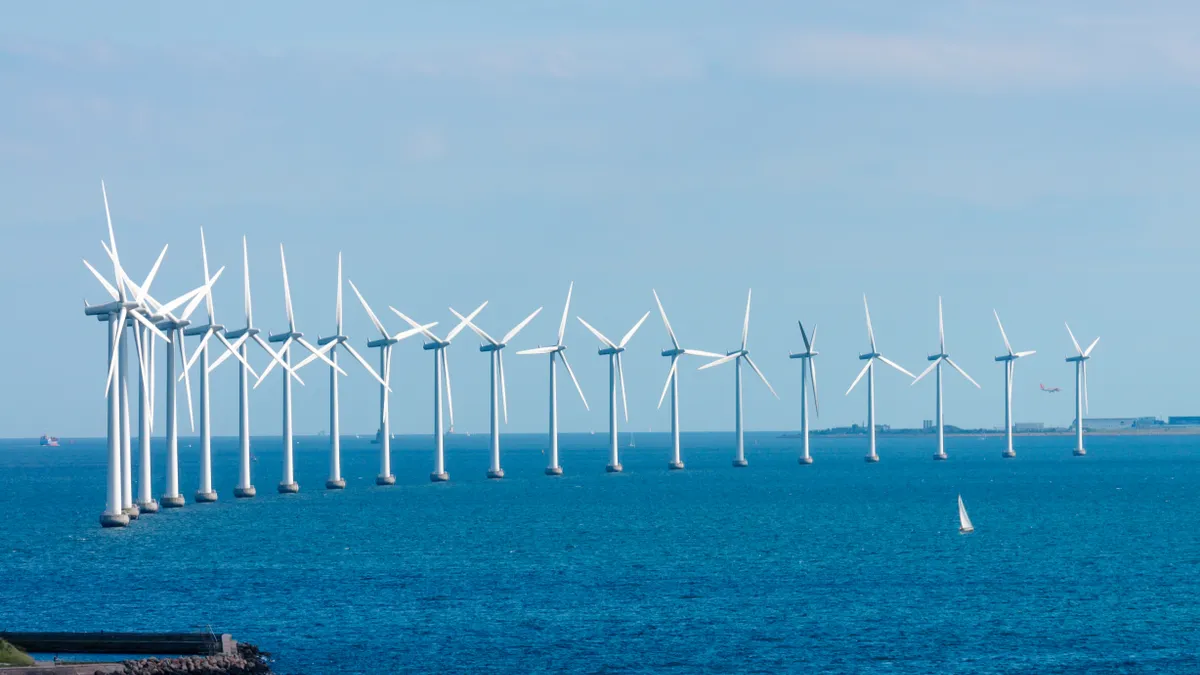Dive Brief:
-
The potential benefits of building a regional transmission network to connect offshore wind farms on the Atlantic coast would significantly exceed the costs, according to a two-year study released Thursday by the U.S. Department of Energy.
-
Across all four scenarios analyzed by DOE's National Renewable Energy Laboratory and Pacific Northwest National Laboratory, regional transmission networks generated more than twice as many economic benefits as costs, according to the report.
-
An accompanying action plan released alongside the study calls for the immediate creation of a multi-state transmission collaborative on the East Coast.
Dive Insight:
Building a regional transmission network off the Atlantic coast could come with significant benefits for developers, utilities and electric customers in the region, but it won't come without some significant upfront costs, according to the DOE offshore wind transmission study.
The study evaluated the potential of four high-level concepts for connecting Atlantic coast offshore wind farms. The most ambitious scenario, which involves the construction of a transmission “backbone” down the entire Atlantic coast, could cost around $116.3 billion — $20 billion more than building radial transmission lines for individual offshore wind projects. But this backbone of transmission could also yield nearly $2.5 billion in net annual benefits, according to DOE.
On a less ambitious scale, building transmission lines to connect offshore wind farms located within the same region would cost $3.6 billion above the cost of radial transmission lines,— but would generate $330 million in net annual savings, according to the study. This scenario divided the Atlantic coast into five geographic regions.
The majority of the economic benefits for all the concepts would come in the form of reduced production costs, including reduced operations and maintenance, reduced startup and shutdown costs, and reduced fuel costs, according to the study. But modeling from the study suggests that the network would also reduce offshore wind curtailment by 1-2 percentage points.
The study demonstrates that the current paradigm of building radial transmission lines for each offshore wind project is not the most efficient means of connecting offshore wind to the grid, said Cullen Howe, a senior advocate for energy transmission at the Natural Resources Defense Council. A regional network would also reduce the impact of offshore wind development on natural ecosystems, and make interconnection easier for future offshore wind projects, he said.
But regional transmission — whether onshore or off — isn’t making much headway anywhere in the nation in the absence of a process for coordinating across regional transmission organizations, Howe said. There's also the question of allocating the upfront costs associated with building the network — a question that is not addressed in the DOE study.
“My sense is that we will start to solve some of these issues in the next few years because we absolutely have to,” Howe said. “In 25 years, it may not look exactly like what the DOE has mapped out, but I think we will have a regional transmission network.”
Jeff Dennis, deputy director of transmission in the DOE's Grid Deployment Office, noted that the study assumes a phased-in approach to any future offshore transmission network. For the next six to seven years, he said, the study assumes single-project radial lines will remain the norm, with more integrated transmission built in 2030 and beyond.
In the meanwhile, he said, it will be critical for state leaders to come together and develop a shared vision for offshore wind development. State-level coordination is necessary to engage local stakeholders and find solutions that minimize impacts to local communities and improve community buy-in, he said.
Dennis said the study itself, which involved a series of workshops with tribal nations, state governments and regional transmission operators, serves as a “great illustration of how we can move toward a well-coordinated and planned offshore grid that reduces power production costs for customers, without requiring us to pause near-term actions to continue developing the industry.”













